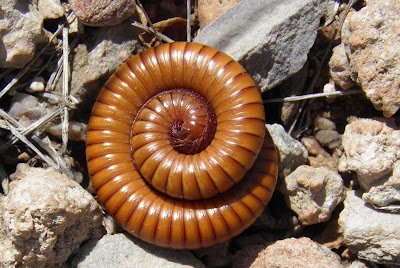On Wednesday I wanted to work my way up through the grassland into Madera Canyon. There was an impressive thunderstorm hanging under Mt. Hopkins and I ended up staying a little further north in Florida Canyon instead. It anyway seemed a good idea to check out the Santa Rita Research Range (SRER) where we'll hold our BugGuide gathering in less than a couple of weeks.
 |
| Left: Termite shedding its wings: middle: male following female: right: ant attack |
Of course, the rain got me soon anyway. A fast and furious thunderstorm lasted only a few minutes, not even long enough to cool down the air. While the thick drops were falling I noticed a familiar phenomenon: hundreds of lithe, long-winged insects were drifting through the moist air. One swipe of my net caught over a dozen: Winged reproductive members (alates) of a nearby termite colony, probably the ground dwelling desert encrusters. In those colonies the workers actually build little structures in the rainy season. From there, they push out the alates that are ready and waiting as soon as a storm hits. I've watched those flights before: they seem to last only minutes. After that, the wings are shed and the termites are milling around on the ground. Many have found a partner: a male following on the heels of a female who seems to be frantically searching for something. I never saw an actual mating. Maybe she's leading him to the privacy of an underground future nest site for that. Their little journey in tandem is dangerous: birds and whiptail lizards were picking the termites up by dozens and the attacks by several ant species were especially vicious. But if they make it, the pair can look forward to a long married life: they may live and stay together as queen and king of a new colony for decades, mating repeatedly and generating all the offspring to populate it.

Along the dirt road towards SRER yellow grasses told of months of draught. But recently the area had received a fair amount of precipitation: The Desert Broom bushes (
Baccharis sarothroides) were oozing: sugary phloem juice leaked from every scrape or cut to the bark. Scores of big insects were at work improving those sources of sweet rewards by chewing and licking.
I watched the big wasps: While the Tarantula Hawk was by for the biggest, the agile Cricket Hunter had the advantage of huge mandibles and much more intense aggression and won the best spot every time. It was still a little early for the bigger Longhorn Beetles, I saw only a single Stenaspis, but the Giant Agave Bugs were out in force. I think this is a promising begin of our rainy season and the BugGuide group has a lot to look forward to.
The SRER station was closed and abandoned, but I took a look around anyway. Here are some photos of the facilities: A building for meetings, bunk house and cottages, work sheds and the managers house are all nestled along a permanently trickling creek under lush trees. The Santa Rita Mountains raise on both sides and several paths allow access - climbing continuously but never really steeply.
 |
| Hanging Thief, Robber Fly, Bee Assassin |
In spite of the stormy weather there were still insects out around the trail, most of the obvious ones were large predatory species.
 |
| Black lighting sheet with mostly Scarabs |
Monsoon storms usually do not last very long. After a couple of hours the afternoon sun broke through and promised a productive evening for black lighting when I finally made my way to the upper parking lot in Madera Canyon.
 |
| Strategus cessus |
It stayed a little bit on the cool side at 72 Degrees Fahrenheit. Some insect species prefer warmer night time temps. I saw only one big
Prionus heroicus at a light that I had placed in a very protected spot in the forest. Out in the open, this was the night for
Strategus cessus that I had never seen in such numbers. Most
S. cessus are smaller than
Strategus aloeus and they are all black on top. They have the pronotal depression typical for the genus, but no horns. So I'm not quite sure how to tell males and females apart.
 |
| Eacles oslari found its own camouflaged spot on one of the interpretative signs that were installed by the forest service |
Lots of
Chrysina beyeri, but no
C. lecontei at all, many nice shpingids, but only one big saturniid moth,
Eacles oslari. Over all, a good collecting night that ended eventually when another thunderstorm rolled over the mountains.
 |
| Lophocampa argentata (Silver-spotted Tiger Moth |









































